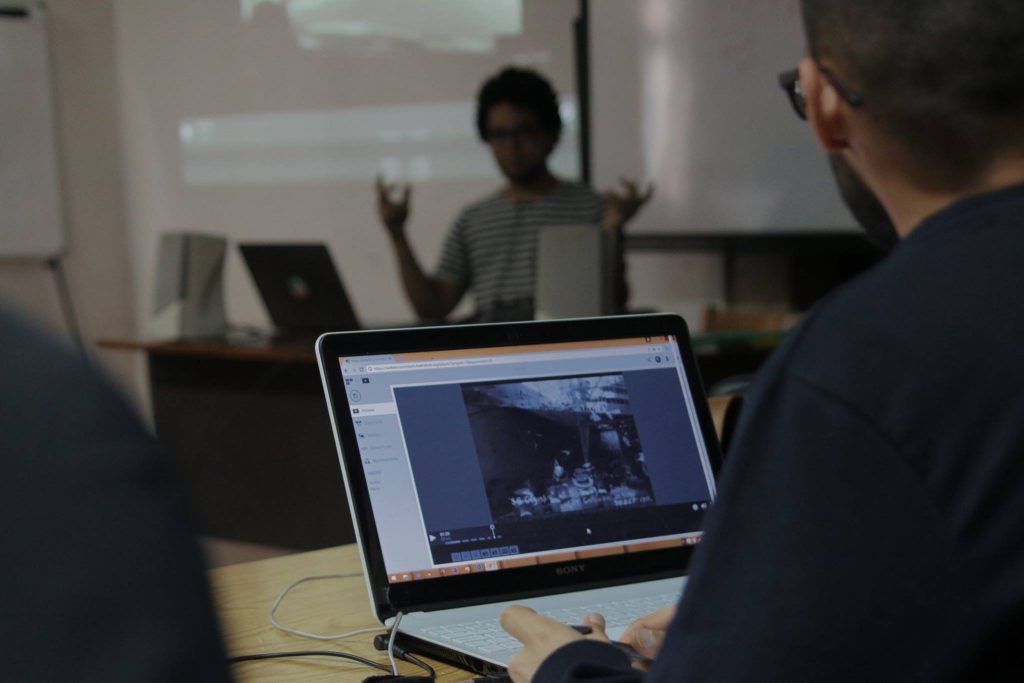Last week, I was invited to the WebDocumentário Conference in Covilhã for a Keynote Talk and a 3-day FrameTrail Workshop. After arriving in Lisbon on Tuesday, it was time for a 3,5 hour train ride to Covilhã on what must be one of the most beautiful tracks in Europe. I just kept staring out the window, looking for the next stunning river, valley or nicely decorated little train station, continuously thinking how lucky I am that I can actually call this “work”.

Keynotes & Round Table
On Wednesday, the conference started with a keynote by Rafael Antunes on “Convergent Culture and Transmedia Narrative” (in Portuguese, but I kind of got the plot), followed by Charles Ayats, who showcased several of his beautiful and aesthetically pleasing projects in a keynote on “Game Design & Interactive Documentary”. In my keynote, I focused on the “Web” in WebDoc, trying to combine the first hypertext ideas from 1945-1990 with state-of-the-art web video technology, open source film concepts and recent real world scenarios like the BBC R&D Object-Based Media approach.
The keynotes were followed by a discussion round on the future of web- & interactive documentary, which was interesting, but didn’t really end with a satisfying conclusion or tangible outlook into future developments (like most of these panels, really).
FrameTrail Workshop
The first three hours of the workshop were needed to explain the basic concepts of both web video formats and the FrameTrail application, followed by a hands-on introduction on how to use the application. After that, we were ready to get started with the actual projects.
Thankfully, the students had already been prepared, so they showed up in mixed teams of Multimedia Design and Cinema students, with a more or less precise project and story they want to work on. The projects were divided into the categories:
- Interactive Narrative
- Visual Essay
- Found Footage / Archive
Each team presented their project idea and we evaluated together, how these ideas could be implemented using FrameTrail. In parallel, we set up all the projects in FrameTrail, so everyone could start uploading their first resources and materials.
The annoying practice of video conversion into two formats (yes, there’s still not one format for every browser) turned out to be a bigger drawback than expected, same goes for uploading the videos through a very slow connection. But in the end, every team was able to present their project on Friday and I’m very happy with the outcomes.

It would be great to showcase some of these projects here, but as they will be further developed until the end of this semester, I will wait for the final presentations of the students (which I’ve been promised to be invited to join via Skype).
Conclusions & Lessons Learned
Right now, I’m back in Lisbon, enjoying the rest of the week-end and reflecting on the last days from a beer-in-my-hand-sun-in-my-face perspective.
Using the main FrameTrail features turned out to be an easy task, which most participants managed to do and figure out on their own. However, there were several very basic problems with the naming of features (like Annotations, Overlays, etc.) and especially with understanding their differences. Although I tried to point this out in the “Getting Started Tutorial”, it seems there is much more explaining to do on that front. This of course also relates to the interface design and user experience issues in the authoring part of the interface. It was very helpful to be able to look over participants’ shoulders and spot the issues and misunderstandings with certain workflows or interface elements.
The fact that the images, webpages, maps etc. you add to a FrameTrail project are not automatically shown in an optimized, dynamically adjusted layout, showed me very well, how expectations rise, as soon as you provide a user interface for web development operations. If you do it yourself, it’s your fault, if you just clicked a button, it’s the button’s fault. And in many cases, the button also doesn’t let you correct it, so you are stuck with the presented solution with no way out. The consequence are either more buttons, choices and user experience improvements or going back to a code editor box, where you can make all mistakes, but are also, at least in theory, able to fix them.
Another challenge was the naturally little / non-existent web technology knowledge of Cinema and Multimedia Design students. While FrameTrail can of course be used without any programming, the recently implemented “custom code” features widen the spectrum of possibilities into all directions, even until projects, where FrameTrail is just the bootstrapping tool that helps to manage resources and time-based events. Not using these possibilities is thus quite limiting, which is why I did my best to help the students with some code snippets here and there. A rewarding moment was, when I saw how quickly they were able to re-use the bits of code without any coding skills whatsoever. I seriously hope this took away the initial fear of the code editor areas, at least for some.
An interesting observation was also how such projects kind of invert the workflow of a filmmaker: you have to render, export and transcode the final videos, before you can actually start working (not that “generating” the films wouldn’t be work, but in a FrameTrail project, they are just the raw material to get you started).
Wrapping up: I had a great time in Covilhã, it was an awesome experience to see a room full of 20 people somewhere in a Portuguese University working with FrameTrail and last but not least: I was perfectly taken care of, be that hotel, lunch, the cozy tavern in the evening or just everyday things during the week. Thanks a lot for all that, especially to Luis Frias, you made me feel a little bit like on holidays (the weather might also have helped)!

